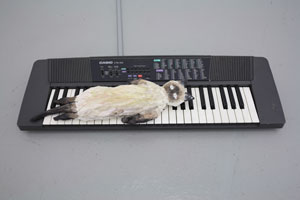|
Tam Ochiai's work is deceptive. On the face of it, Ochiai's exhibition seems simple to the point of naivete -- light line drawings, non-sense text, basic form sculptures, thin yet layered paintings leaning against the wall and hanging as well as a video of cats at play -- all installed within the gallery with an ultra-light, seemingly effortless touch. It is through this lightness that one gains an entrance into what ultimately reveals itself to be an intriguing and finally generous, even hopeful exhibition. Ochiai, born in Japan but based in New York, is a rare creature; a hipster of one who utilizes a private language not to defend himself through surface difference but, rather, to attempt a form of uncompromised, perhaps even "direct" communication. Light but not so light as to be easily dismissed, Ochiai's installation prompted a second, more careful look; particularly in light of the fact that supporting the work is the public, long-time admiration of art critic and Micropop curator Midori Matsui. Perhaps the most representative work on view was a small partial ready-made featuring a reclining cat sculpture placed upon a Casio electronic keyboard producing a gentle drone.
|
 |
|
Cat sculpture, 2007, 84.5 x 28.0 x 12.5 cm
Courtesy of Tomio Koyama Gallery,
Photo by Ikuhiro Watanabe
|
|
|
More than simply charming, the sculpture and its accompanying sound invited a relaxation of critical perception and prompted an easy-going re-read of the works on view. A humorous though not hilarious joke was at the heart of the exhibition's heaviest element, a series of minimal forms placed within the main exhibition space. Suddenly, it became clear that this minimalism was being experienced second-hand and that the first beings to have a phenomenal encounter -- documented by the artist in a film projected low on the gallery wall -- were cats. And it is this first experience, cat-scratches, trace paw-prints and all, that helped to shape one's initial perception of the installation. Ochiai's strategy is one of simplification and repetition; through his use of these elements, he is able to trick one into reading his work, something which requires one to think as the artist, so to speak, albeit mentally, in Ochiai's tongue. Though it is necessary to think as Ochiai to read the work, there is no sense of aesthetic fascism at play as one is not forced into thinking differently -- one chooses to change gears in order to more fully enjoy the experience of the artist's work. And it is then that a sort of elementary joy is possible, an experience of language so foreign as to prompt a recollection of the sense of reading for the first time. The work ultimately is not "about" language but is a hybrid of the minimal and conceptual practice which requires an active engagement to make any sense at all. Given the work's lightness, one can't help but enter into this game -- if only out of a fundamental desire to understand. In the end one is left with a sense that if it is possible to understand Ochiai, it may be possible to understand and communicate more clearly without compromising one's own means of navigating and communicating within the world. The exhibition is a model to be sure, but one which functions beyond the limited context of the gallery.
|